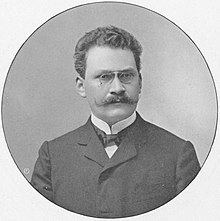
Back Hermann Minkowski Afrikaans هيرمان مينكوفسكي Arabic هيرمان مينكوفسكى ARZ Herman Minkovski Azerbaijani هرمان مینکوفسکی AZB Герман Мінкоўскі Byelorussian Херман Минковски Bulgarian হেরমান মিংকফ্স্কি Bengali/Bangla Hermann Minkowski Catalan Hermann Minkowski Czech
Hermann Minkowski | |
|---|---|
 | |
| Born | 22 June 1864 |
| Died | 12 January 1909 (aged 44) |
| Citizenship | Russian Empire[1] or Germany |
| Alma mater | Albertina University of Königsberg |
| Known for | |
| Spouse | Auguste Adler |
| Children | 2 |
| Scientific career | |
| Fields | Mathematics, physics, philosophy |
| Institutions | University of Göttingen and ETH Zurich |
| Doctoral advisor | Ferdinand von Lindemann |
| Doctoral students | Constantin Carathéodory Louis Kollros Dénes Kőnig |
| Signature | |
| Special relativity |
|---|
 |
Hermann Minkowski (/mɪŋˈkɔːfski, -ˈkɒf-/ ming-KAWF-skee, -KOF-;[2] German: [mɪŋˈkɔfski]; 22 June 1864 – 12 January 1909) was a mathematician and professor at the University of Königsberg, the University of Zürich, and the University of Göttingen, described variously as German,[3][4][5] Polish,[6][7][8] or Lithuanian-German,[9] or Russian.[1] He created and developed the geometry of numbers and elements of convex geometry, and used geometrical methods to solve problems in number theory, mathematical physics, and the theory of relativity.
Minkowski is perhaps best known for his foundational work describing space and time as a four-dimensional space, now known as "Minkowski spacetime", which facilitated geometric interpretations of Albert Einstein's special theory of relativity (1905).
- ^ a b Encyclopedia of Earth and Physical Sciences. New York: Marshall Cavendish. 1998. p. 1203. ISBN 9780761405511.
- ^ "Minkowski". Random House Webster's Unabridged Dictionary.
- ^ Cite error: The named reference
Encyclopædia Britannicawas invoked but never defined (see the help page). - ^ Cite error: The named reference
:1was invoked but never defined (see the help page). - ^ Cite error: The named reference
:2was invoked but never defined (see the help page). - ^ Cite error: The named reference
:3was invoked but never defined (see the help page). - ^ Cite error: The named reference
:4was invoked but never defined (see the help page). - ^ Cite error: The named reference
:5was invoked but never defined (see the help page). - ^ Cite error: The named reference
:6was invoked but never defined (see the help page).